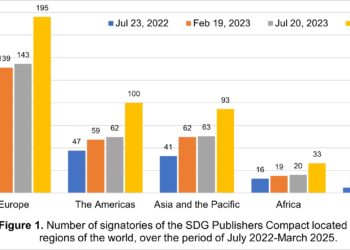This piece is based on a conversation with Ed Pentz, the Executive Director of Crossref. Since its founding in 2000, Crossref has been for me a shining example of how publishers — and other stakeholders across the publishing industry – can come together to collaborate around metadata.
Ed is the ideal ambassador for such a collaborative organization. Entrepreneurial in spirit, charming in person, and practiced in consensus building, Ed has been able to lead the organization from humble beginnings and lofty ideals, to a place where Crossref is now seen as essential far beyond the publishing industry and into academia, funding agencies, and industry. I wanted to know from Ed why it is that Crossref has been such a success. How does Ed see the publishing landscape evolving in the face of an evolving plethora of non-profit collaborative service organizations, in addition to the many for-profit start-ups, all asking for publisher dollars to support their work? Is consolidation of service organizations in Crossref’s future?

Crossref was set up in 2000 by several publishers who came together in enlightened self-interest, eager to find a collaborative way to fight link rot and make reference linking scalable. Crossref was designed to be resolutely neutral, forming no opinions on politically sensitive issues such as open access, subscription models, etc. Ed Pentz came from one of these publishers, Academic Press, where he was heavily involved with the development of the digital object identifier (DOI). Using start-up loans from publishers, Ed took what was a prototype production system and built it out, hiring staff on the technology side as well as those who could enable the growth of Crossref as a membership supported organization. The focus was on collecting metadata, recording DOIs, and getting contacts into the system. Crossref went on to develop a sound business model based on issuing DOIs, not relying on membership fees for support and growth, an especially difficult proposition in an era of consolidation and fewer potential members. Crossref was solvent by year three, and had paid off all its loans by year seven.
Subsequent years focused on more of the same, though as time progressed, more types of content were added, including books. Reaching out further, Crossref launched Similarity Check (first known as CrossCheck), an initiative powered by the iThenticate software package that allows users to check for plagiarized content. This is now in widespread use across many journals. They also launched various initiatives, such as Crossmark – a tool that enables tracking whether content has been updated, corrected, or retracted and Cited-by, a tool that allows users to see what other Crossref content is citing their content. From this you can form a mental image of how a small collaborative partnership expanded its reach across the publishing workflow, with all of its activities operating quietly behind the scenes. One other piece of the Crossref puzzle that I think may not be entirely transparent is their role in stimulating the proliferation of other non-profit publishing and researcher services that were launched as independent entities. Examples include ORCID and CHORUS (full disclosure, I serve on the Board of Directors for CHORUS).
Crossref recently held a strategic planning retreat in Singapore. New governance is in place, with Paul Peters, CEO of Hindawi Limited, the new Chair of the Crossref Board. As Ed relayed to me, the core of Crossref relies on acquiring good metadata – none of these services are worth very much unless the metadata are near complete and trusted as accurate. A key part of the future for Crossref sits in expanding metadata collection from the widest range of sources, be it publisher metadata, or indeed funder metadata through the Crossref Funder Registry (formerly known as FundRef).
They realized that while Crossref has been quite content to sit quietly in the background, its services are now more prominent across researchers, funders and industry than before, and it is time for the organization to redefine the mission. It was clear that for all we do as publishers in the academic community, and are not recognized for, except mainly for the bad things, even researchers are aware that Crossref is a good thing. Crossref is synonymous with the DOI, and indeed was the originator of its deployment, but now that DOI use has spread – even into the entertainment industry and way beyond Crossref’s original remit — it is time to develop new paths for Crossref and to generate a more overt understanding of where Crossref sits in the publishing and scholarly researcher workflow. A recent initiative, which I think captures Crossref’s new approach quite succinctly, is the launch of an organizational identifier program, which is being launched within Crossref, not as part of ORCID: rather than proliferating new organizations, they are instead consolidating new and existing services. This makes sense to me: as a medium sized society publisher I have to work to justify the myriad fees for using services such as ORCID, Crossref, CHORUS, CLOCKSS/LOCKSS. All of this is in addition to memberships of AAP/PSP, STM, SSP and so on. (And I have not even touched on the many for profit start-up services such as Kudos, Overleaf, or Altmetric, some independent, and many of which are under a larger umbrella, as these latter two in fact are, as part of Digital Science.) Crossref understands this trend, and while Ed would not, quite understandably come out and say that Crossref may wish to consolidate collaborative service offerings, it is quite clear that this may well be a strategic focus that makes sense for Crossref.
The take away message for me is that Crossref has served as a fabulous example of how for-profit and non-profit organizations alike may collaborate when needs must. Moreover, the creative energy that has powered the proliferation of services seems to be turning full circle. It is quite likely that in coming years we will see the full range of services organized by fewer organizations, perhaps all overtly managed by Crossref.
Discussion
3 Thoughts on "Crossref: How Stakeholders Across the Publishing Industry Collaborate"
Crossref is an excellent organiation, which entirely supports the attribution of DOI’s to individual self publishing authors – one can now publish independently, without the need of a publishing company, and obtain a DOI, with all the advantages that this confers. Brilliant!
Hi – I wanted to clarify what Crossref is doing with organization identifiers. We are collaborating with ORCID, DataCite and others and the goal is to have suitable community governance for a organization identifier registry without creating a new organization. There was a stakeholder meeting last week – details are here – https://orcid.org/content/2018-org-id-meeting – there are lots of links to background information from the meeting agenda.
Also agree that CrossRef and its team are brilliant, and that CrossRef is an excellent example of quiet and steady innovation that cuts across publishing houses. Wanted to make the point that there are earlier collaboration projects which were also critical to building digital infrastructures, including the Adonis project which I came across at Elsevier as the project was ending– but which I think was important in establishing that there was in fact a market and interest in digital content being served up in a unified manner. That project is not remembered often these days, possibly because it involved CD-ROMs in a pre-Mosaic period, perhaps because it was billed as a replacement for document delivery/interlibrary loan. I can find only one article on the topic, from The Serials Librarian (1988), “Adonis and Electronically Stored Information” by Constance Orchard, vol. 15, issues 3-4 (the article does have a DOI though!), published by Routledge/T&F, which didn’t have much in the way of a conclusion beyond noting that library markets are interested in the efficiency of electronic publishing and distribution, but that a more significant corpus was required to make the initiative successful. Elsevier was probably more aware of the project than others, given that Elsevier was one of the founding coalition members, and certain other participants were eventually acquired by Elsevier (Pergamon; Butterworth Scientific; Churchill-Livingstone and Mosby). Other publishing houses involved included Springer, Thieme and Wiley. Library and vendor participants included the British Library, KNAW Amsterdam, the National Library of Australia and University Microfilms. I know it is amazing to think of CD-ROMs with scanned journal content being physically shipped around the world, but it might have been more amazing that such a large group of publishers could agree to share in a sense a common platform and of course structural information (DTDs) and metadata. Excuse the history digression, but I think it important to note that publishers often work together for the sake of efficiency and impact.



